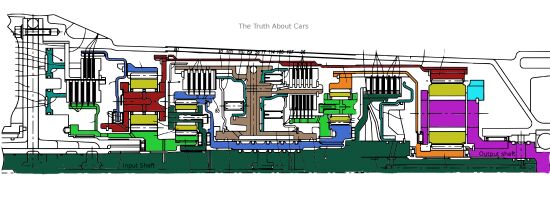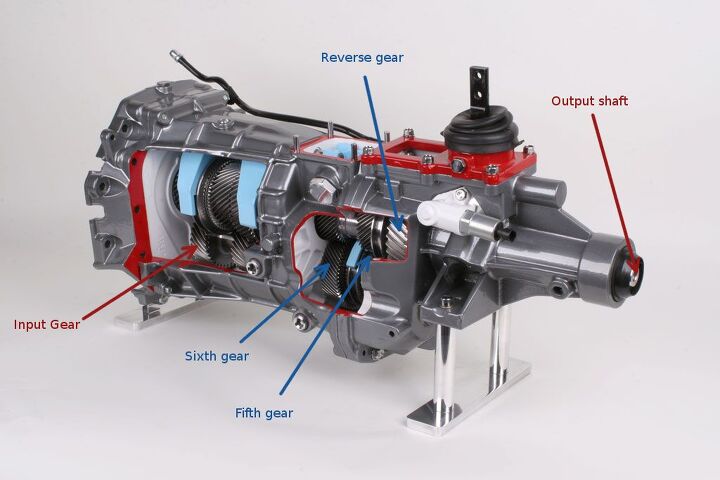#SaturationDive
Saturation Dive: Ford 10 Speed Transmission Power Flow
Ford 10 speed transmission cross section design pieced together from various patent disclosures
If a transmission has 5 clutches and for the realization of a gear ratio 3 out of the 5 clutches have to be engaged, there are a total of 10 possible combinations. The ZF 8HP and GM 8L transmission families have 5 clutches of which 3 are engaged for any gear state, but only have 9 out of these 10 states are present and accounted for (8 forward gear ratios along with 1 reverse gear ratio). The 10th combination leads to a situation where the transmission would want to turn in forward and reverse direction at the same time, i.e. the transmission would lock up the output shaft and potentially self destruct. The Ford 10R transmission design has 6 clutches and 4 are engaged for any given gear ratio. This gives us 6C4 or 15 possible combinations, 11 of which are used to yield 10 forward gear ratios and 1 reverse gear ratio. The 4 other combinations do not yield a functional transmission gear state or put the transmission in Neutral.
In the last article on the Ford 10 speed transmission we looked at some of the design details of the Ford 10 speed RWD automatic transmission without going into the details of the actual power flow for the various gears. In this article, a detailed analysis of the power flow is presented along with the gear ratio calculations and shifting operation of the transmission. Just like the last article on the subject, the information is based on invention disclosures by Ford. The most relevant patent for the purpose of understanding the power flow is US Patent #8545362.
Saturation Dive: Manual Transmission Gear Design
In the automatic transmission racket, there have been new layouts and power flows galore lately. Your humble author has done a few articles detailing some of the more common designs in the North American market place, with the notable exception of the Aisin design. The design of a RWD manual transmission, on the other hand, is conceptually largely unchanged from the earliest 3 and 4 speed designs like the venerable M22 Rock crusher.This is not to say that RWD manual transmissions have not changed over the decades. The number of gears and torque capacities has increased, shift efforts have gone down, refinement has increased, which are all good things. This article provides some insights into the gear design and sizing for some of the more recent manual transmissions.
Saturation Dive: The GM 8L90 Transmission
On the surface, there are many similarities between the ZF 8HP transmission family and the GM 8L90. Namely both use 4 gear sets, 5 shifting elements (3 clutches and two brakes), off axis pumps, and have roughly the same gear ratio spread at about 7:1 overall spread. The saturation dive is not about dealing with things that are on the surface. To be entirely honest as the details started to emerge on the GM 8L family of transmissions I suspected that it would end up being a ZF licensed design, the ZF 8HP after all is a very good design in my opinion. But the abstract of the paper that we managed to snag before SAE took it down revealed one very important detail – all 3 of the clutches were located in front of the planetary gear sets very much unlike the ZF design.
Saturation Dive: ZF 8-Speed Automatic
For those who don’t share my fascination with diving, a saturation dive is conducted at deep depths for extended periods of time at depths of hundreds of feet. I have read with bemusement the various “deep dives” that have been conducted by various publications into the workings of modern automatic transmissions. These deep dives tend to be more akin to splashing about in the shallow end of a pool. The name Saturation Dive is an engineer’s attempt at humor, namely to convey that this series of articles is much deeper than the stereotypical deep dives.
















Recent Comments